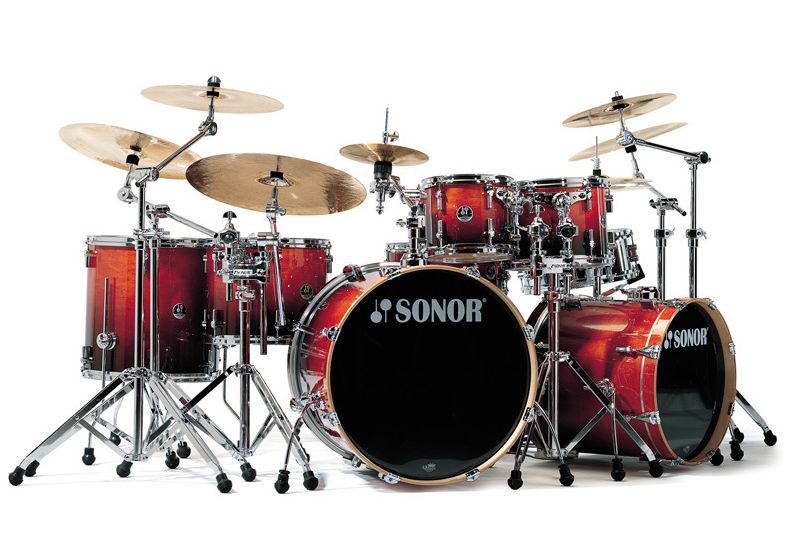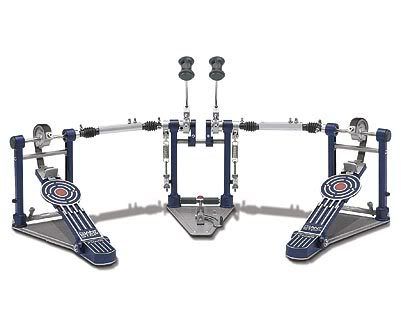 | SONOR FORCE 1007 DRUMSET - STAGE 1 - AMBER FADE On order SORRY, THIS ITEM IS CURRENTLY NOT AVAILABLEThe Sonor Force 1007 Set ? designed especially for beginners at an uncompromisingly attractive price. Extremely interesting for all up-and-coming rockers, jazz drummers, enthusiasts of metal or of the blues ? looking for a drum set that is sturdy, yet versatile. The 9-layer Basswoodshells of the Sonor Force 1007 Sets are characterised by a full-bodied, balanced sound with lots of power up front. Bass Drum 22" x 17.5" Snare Drum 14" x 5" Tom Tom 12" x 9" Tom Tom 13" x 10" Floor Tom 16" x 16" 4-piece Hardware 200 Set Throne and cymbals not included. |
SONOR FORCE 1007 DRUMSET - STAGE 1 - AMBER FADE |
12" x 9" Tom
13" x 10" Tom
16" x 16" Tom Basse
14" x 5.5" caisse claire
Set d'accessoires série 200 comprenant :
1 pied de caisse claire (SS 277)
1 Pédale de grosse caisse (SP 473)
1 Pédale charleston (HH 274)
1 Pied de cymbale perche (MBS 273)
Livrée sans siège ni cymbales
Gear review – Sonor Giant Step Middle Pedal
Alright then, this is the Sonor Giant Step Middle Pedal… which is a really long name to type out so I’m gonna abbreviate it as GSMP. This was the last pedal I used before I sold my drum-set for reasons I shall not disclose. The Giant Step series is Sonor’s high end line of pedals and all share some basic features. Most of which I appreciate, one of which I wish they would have made optional or removed altogether. One of the things I really do like is the docking station. The docking station is a small clamp that you put on your bass drum hoop where you would normally clamp the pedal. Once you’ve got it on the way you like it you just leave it on. From there all you have to do is slip the male locking mechanism on your giant step into the docking station and pull the lever on the bass plate of your pedal. Bam! your pedal is attached. It really makes setting up and switching pedals a breeze… as long as you use another GS (giant step) pedal. If you want use some other variety of pedal you have to unclamp the docking station because It’ll get in your way. I hope that all the manufacturers adapt a similar idea and create a universal docking station. It really is a smarter way to get things done. Another thing that I like is the pendulum action mechanism that holds the bottom end of the spring. Think of it as Sonor’s answer to DW’s floating rotor system found on their 9000 (and the new 8000) series pedals. It increases the smoothness of the bass pedal’s action and sensitivity, which is always a plus. The last major feature of the GS series that I like is the fact that you can adjust the length of the pedal. this effectively allows you to move the “sweet spot” of the pedal to your personal specifications. This is another feature I hope that other manufacturers eventually integrate into the design of their pedals.
The one feature of the GS pedals that I don’t care for is the anti-slip rubber. I understand how other people like this feature but I wish it were optional.Designed to keep your feet from slipping up and down the pedal when you’re playing, I can’t say that it doesn’t do its job. The problem is that lots of different bass pedal techniques involve sliding your foot on the pedal. Jojo Mayer’s bass pedal technique comes to mind here. I might note that Jojo, a Sonor endorser, doesn’t use their GS series pedals. This may or may not have anything to do with the anti-slip rubber but I thought i’d throw it in there. Now, it’s not impossible accomplish techniques that involve sliding the foot on this pedal. It’s just more difficult. I wished they would have made this optional/adjustable like Pearl did on their Eliminator pedals, but, as a song once said, “you can’t always get what you want.”
Moving on to the specifics of the GSMP. The idea is to eliminate the asymmetrical action of most standard double pedals by eliminating the master-slave configuration of most standard double pedals. They accomplish this by having two slave pedals and a stand alone bass plate where the two beaters are located. This idea wasn’t invented by Sonor, in fact the the first pedal double pedal that didn’t use the master-slave concept was invented by Don Sleishman. The same Sleishman who makes the all free floating drums. In fact, according to his website www.sleishman.com this variety of double bass pedal came before the master-slave style pedals. Making him the father of double bass pedals. For some reason or another this style of pedal didn’t take off and was nowhere to be seen until Sonor re-introduced this style of double pedal with the introduction of their GS series.
I’m just going to say here and now that I am mostly a single pedal kinda guy. I like one foot on a hi-hat, one foot on a bass pedal. That’s just how I roll. When I want fast bass drum work, I’m more likely to use some of John Blackwell or Jojo Mayer’s foot techniques to get speed. I rarely go for the other bass pedal. I don’t know what possessed me to buy this thing. It’s totally not my style and it costs over 1000$ with taxes. Anyways… The pedal is basically two slave pedals and it feels like it. They are a bit sluggish and it can be difficult to do intricate single pedal work on this thing. Like other slave pedals, the more you extend the drive shaft and/or have an odd angle between the slave and master components, the more sluggish the response is going to be. So naturally I wanted them as compacted and straight as possible. The problem is that, while double bass playing is very easy in this set up, if you try trying play the hi-hat with your foot you’ll probably find that the angle between your legs is wider than you’re comfortable with. If you are a gymnast or regularly practice Yoga then this might not be a problem for you. Your other option is to put your hi-hat inside in-between your two bass pedals, Billy Ward style. The problem there is that to accomplish this you need to really extend the drive shaft of one of your slave pedals. This makes one of the pedals much more sluggish than the other. So at best it’s the same as a regular double kick. At worst it’s a dysfunctional piece of crap that you spent 1000$ on.
The other thing is that one of it’s main selling points is that it gives a double kick feel to a kit with one bass drum. Well, the reason that most single kick kits with regular double pedals feel different from true double kick kits has more to do with how kits are traditionally set up as opposed to the nature of the double pedal you are using. Most typical drum-sets are set up with the kick directly in-front of you and the hi-hat roughly next to the snare. This puts one foot waaaay closer in to your body than the other. A double kick setup is more natural because each kick is off to one side. Well if you put your bass off more to one side, you can place your pedals in a double kick configuration and then you have the same feel as a double kick kit! All that and you don’t have to drop a grand on a fancy pedal.
This pedal gets 2 star out of five. I was going to give it 1 star but I gave em’ another point because they brought renewed interest in a concept that might of died otherwise. I gotta say that I like the concept, I really do… however this is just the really flawed product of what could be a really solid idea. The good thing is that this isn’t a purchase that you’re going to just accidentally make. It’s 1000 dollars, if you make purchases of that size without thinking about it first then you need to give some of that money to charity, drummer talk, or me.



















0 comments:
Post a Comment